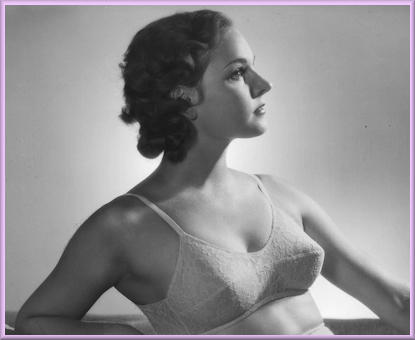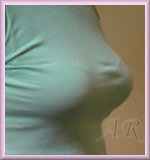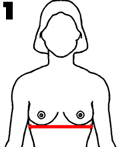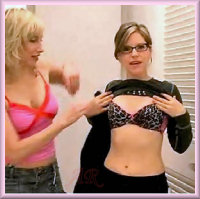|
The bra or brassiere has a long
and convoluted
history that goes back to a least Roman times - and probably far
earlier. There are many claims as to when the modern bra appeared,
but I think the American advert below from 1934 shows a strong
contender.

Every woman with
breasts - regardless of whether she is a mature CIS-woman or a young transwoman
taking hormones - can benefit from a well fitting bra. The
benefits are numerous but the most important are appearance,
comfort, reduced back strain and reduced sagging.
 Just
how great these benefits are in reality is the subject of much argument, with the context that Homo Sapien women survived
without bra's for maybe 200,000 years. There is also some conflict -
a women with large breasts may prioritise comfort, whilst a woman with
small breasts may prioritise appearance. However few women
would voluntarily give up their bra. This page makes the assumption
that a well fitting bra is a good thing, and that a badly fitting bra is
... well ... a bad thing. Just
how great these benefits are in reality is the subject of much argument, with the context that Homo Sapien women survived
without bra's for maybe 200,000 years. There is also some conflict -
a women with large breasts may prioritise comfort, whilst a woman with
small breasts may prioritise appearance. However few women
would voluntarily give up their bra. This page makes the assumption
that a well fitting bra is a good thing, and that a badly fitting bra is
... well ... a bad thing.
It will be
of no great surprise to readers to learn that a woman's breasts come in all
shapes and sizes. Breast size and shape is most commonly described
using classifications developed by the lingerie industry and brassiere
manufacturers. Unfortunately these "standards" are often confusing
and far from consistent. The guidance below is intended for women in the UK and Ireland, but
much is applicable more widely.
Measuring Your
Bra Size
To determine your correct bra measurements, as used by most (although
confusingly far from all!) foundation garment manufacturers:
A) Determining your
Bra Size
- Use a cloth
measuring tape directly under the bust, checking
in a mirror to make sure that the tape is straight across back - this
is the "chestband size".
- If the chest
band
size is an odd number add 5 inches, if it's an even number add 6
inches. Note
the measurement, it's your
actual frame size.

- Measure around
the chest at the fullest part of the bustline. The measuring tape
should be held horizontal (check back in a mirror), and your arms
should be down. Make a note of the "bust size" measurement
and compare it to the Bra Size from step 2.
B) Determining your Cup
Size
- "Cup
size" is a measure of the volume of the breast, and is denoted by
the first letters of the alphabet. Bra cup size classification
is as follows (going from smallest to larger): A, B, C, D, and
DD (also known as Double D or sometimes called E), etc.
To determine the
proper Cup Size, find the difference between step 3 and step 2 (i.e.
bust size - frame size) Use the chart below to determine your cup
size.
Chart
to Determine
Bra Cup Size |
|
Example: |
|
|
|
Difference
|
|
Cup
Size
|
Step
1: Chestband measurement is 31". Add 5 inches. Frame Size
is 36.
Step 2: Full bust measurement is 39".
Step 3: 39 - 36 = 3" difference. Cup size is C.
Result:
Buy a 36C bra.
|
|
Half
inch
One inch
Two inches
Three inches
Four inches
Five inches
Six inches
Seven inches |
|
AA
cup
A cup
B cup
C cup
D cup
DD or E cup
DDD or F cup
FF or G cup |
|
 Notes: Notes:
- Also available
are training bra's which are roughly equivalent to size AA.
These are made from stretchable materials and especially designed for
supporting the rapidly expanding breasts of prepubescent girls.
Training bra's are also very useful for transsexual women who have started
hormone treatment, but unfortunately training bra's are very rarely
available in the shops above frame size 34 and the largest I have
found on the Internet is a size
36 from brafitters.com
(this is not a recommendation, I have never used the company).
- Although
uncommon, the large cup sizes of H, I and J also
exist. These bra sizes are [obviously] needed by very
large-breasted women, or women whose size increases substantially with pregnancy and
nursing.
- For sizes
DD (aka E) and above, accurate measurement can become difficult and
great care must be taken to ensure a proper fit.
- Women whose
actual under bust chest band size is over 33" should always try reducing their frame size by one size, i.e. if they
calculate they needed a 40B bra, a 38B bra on the last hook may well prove
to be a better fit.
- Annoyingly, some bra
manufacturers deliberately make their bra slightly large in order to
flatter the potential buyer, e.g. a bra marked 38C may best fit a 40B
woman.
- Many garment
manufacturers recommend that bra size measurements should only be
taken while wearing an existing comfortable and unpadded bra that fits
well.
- If you are
taking these measurements for use with breast forms (prostheses) you
can simply take the frame size measurement (Step 2) and then choose
the cup size that is right for you.
- Long line and
3/4 bras should only be considered if their length is LESS than the
distance from the under bust to the natural waist line.
Fit
A properly fitting bra is crucial to your best appearance. A bra that fits
correctly will touch your chest at the sternum and support your bosom at
mid-chest without bulges.
 |
 |
Badly fitting
bra
1. Straps digging into shoulders. Go down a band/back size.
2. Breasts bulging over the bra. Too small, go up a cup size.
3. Bra rides up at the back. Too big, go down a band/back
size.
4. Front of bra sits away from chest wall. Go down a band/back
size. |
Well fitting
bra
1. The breasts are smoothly enclosed in cups with no bulging.
2. The front of the bra lies flat against your body.
3. The bra is firm but not tight and leaves no red marks on your
body when taken off. |
A well fitting bra
should have:
Good support:
cups that fit all the way around each breast and keep them from sagging,
straps that don't have to carry so much of the weight that they dig into
your shoulders, not only permanently indenting them but adversely
affecting circulation to and from the arms. One factor is choosing
wide-enough straps, so they're not so thin that they cut, another is a
properly fit cup.
Good coverage:
modesty is an influence in how the cups should fit, with the exception of
some deliberately immodest cup styles. Halters and bathing suits come to
mind here, because they're outer garments and must be made more modest.
Always be thinking about not only your audience, but whether this garment
is to be used as an outer garment.
Snug-enough
chest band: this should not, as with straps, dig into your flesh, it
should be snug enough to still be snug enough at the end of a long day,
but not bind and dig. When the chest band is too snug, it also draws
the underwire into your ribs and will bend them along the lower cup side
or the bottom, digging them into your ribs. By the end of the day,
this has been shear torture. The band should fit well enough not to
slide around long your chest. If you can put the band on backwards
and slide it round your chest to the front, it's too loose. Wear a
smaller size or use the next-smaller row of eyes.
Underwires that
don't poke: if the underwire is poking under the arm it may be too
long, a possible solution being to find or alter a design in which the cup
side is a little lower, or use a slightly less deep (maybe by nipping and
retipping) wire in that style or pattern of bra. Also, if the cup
side seam is too far forward, as with a too-small cup size, the wire will
poke your arm, even more so if it's too deep. This can also result
from a wire that's too wide, moving the tip too far under your arm and
poking you. If the underwire at the centre front does not lie flat,
but comes out at an angle from your body or curves or is anything but
vertical along the chest wall at centre front, it's not right.
Adjust the straps, or find a style or size of bra in which the centre
front ends of the underwire will lay flat against the centre of your chest
and be snug enough, with enough cup room and support to be comfortable and
effective without digging or sagging, poking or bulging anywhere.
To see if your bra
is suited to your bust type (low, high, full, etc.), try this test: Stand
in front of a mirror. Tie a string around your waist. Hold something
straight (like a yardstick or even a pencil) horizontally at your
collarbone (the two bones at the base of your front neck). The
fullest part of your bosom should be no lower than mid-chest level,
halfway between the string and the stick. If your bosom is closer to
your waist, you need a bra that will lift your bosom. (Many women think
they are short-waisted when they are just low-bosomed.) Next, place
your finger on the cleavage area of your bra and press. You should
not be able to bounce your finger in and out; if you can, your bra cups
are too small. Then feel along the front edges of your bra and down
the seam under your arm. Are there any bulges? If so, you need
a larger cup.
Examples
The photographs below show examples of varying breast and cup sizes.
 Breasts
are usually asymmetrical, meaning that one woman's breast may be a
different size or shape than her other breast. Interestingly, a
woman's left breast is usually a little larger then her right breast,
though this is only a generalization. The woman shown
has a left breast that is larger than her right breast, in fact, many of
the photos above show breast asymmetry. Breasts
are usually asymmetrical, meaning that one woman's breast may be a
different size or shape than her other breast. Interestingly, a
woman's left breast is usually a little larger then her right breast,
though this is only a generalization. The woman shown
has a left breast that is larger than her right breast, in fact, many of
the photos above show breast asymmetry.
Inverted
nipples are also quite common and are not a problem unless they cause
difficulty during nursing. Special nipple cups can be used to help
during lactation. A nipple that previously was not inverted but then
became inverted is a warning sign of breast cancer and needs to be brought
to the attention of a doctor:
Atlas of Cup
Sizes
Just for fun, the image
below (sourced from a German magazine) claims to show the average bra size of women around the world.
I suspect that it is very inaccurate!

|


 Notes:
Notes: